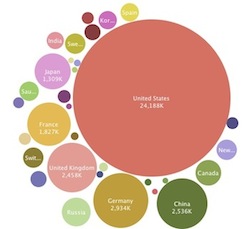Well, its time again for the semi-annual HPC community feats of strength with the release of the fall Top500. You can of course find the list itself here, and the release here, but here are a few things I took away.
Cray’s Opteron-based XT5 system at ORNL took the top slot away from LANL’s IBM RoadRunner system following an upgrade from quad- to six-core, and we now have a 2 PF (theoretical) system on the list
Jaguar, which is located at the Department of Energy’s Oak Ridge Leadership Computing Facility and was upgraded earlier this year, posted a 1.75 petaflop/s performance speed running the Linpack benchmark. Jaguar roared ahead with new processors bringing the theoretical peak capability to 2.3 petaflop/s and nearly a quarter of a million cores.
When the Roadrunner system at Los Alamos first appeared at the top of the June 2008 TOP500 list, it was the world’s first petaflop/s supercomputer. This time around, Roadrunner recorded a performance of 1.04 petaflops, dropping from 1.105 petaflop/s in June 2009 due to a repartitioning of the system. In both November 2008 and June 2009, Jaguar came close but couldn’t dislodge Roadrunner from the top slot.
There’s actually quite a big gap between number one and number two now. Cray and IBM hold slots 1-4, but China now shows up in slot 5 — the highest ranking ever for a system in that country.
Rounding out the top 5 positions is the new Tianhe-1 (meaning River in Sky) system installed at the National Super Computer Center in Tianjin, China and to be used to address research problems in petroleum exploration and the simulation of large aircraft designs. The highest ranked Chinese system ever, Tianhe-1 is a hybrid design with Intel Xeon processors and AMD GPUs used as accelerators. Each node consists of two AMD GPUs attached to two Intel Xeon processors.
And, in terms of chips, 402 systems on Top500 list feature Intel processors, including three in top 10. Intel has come a long way since they were nearly forced off the list in 1999 (when they had only 1% of the Top500).
I don’t typically spill a lot of ink on the Top500 list because so many other people do; if you are hungry for more analysis, Timothy Prickett Morgan at The Register does a particularly good job this year.
 Here is the bubble chart (click for larger image) from the latest list showing the distribution of Rpeak GFLOPS by country (you can interact with the visualization in realtime at the ManyEyes site). Qualitatively, not much change from the June visualization; the world’s FLOPS are still highly concentrated in just a few countries, nearly all of which are north of the equator (New Zealand, Australia, and South Africa being notable exceptions).
Here is the bubble chart (click for larger image) from the latest list showing the distribution of Rpeak GFLOPS by country (you can interact with the visualization in realtime at the ManyEyes site). Qualitatively, not much change from the June visualization; the world’s FLOPS are still highly concentrated in just a few countries, nearly all of which are north of the equator (New Zealand, Australia, and South Africa being notable exceptions).



